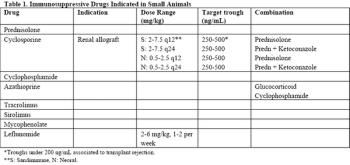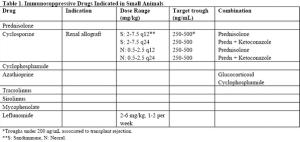
Although newer therapies are being developed in humans that allow a certain targeting specificity, immunosuppressive therapy in dogs and cats is largely based on the use chemotherapeutic drugs.

Although newer therapies are being developed in humans that allow a certain targeting specificity, immunosuppressive therapy in dogs and cats is largely based on the use chemotherapeutic drugs.

Feline asthma consists of an inflammatory disorder of the lower respiratory system of cats that results in bronchoconstriction and limited airflow to the lungs.

For many years, short and long-term therapy of epileptic disorders in dogs and cats has been based on the use of benzodiazepines (e.g. diazepam), barbiturates (e.g. phenobarbital) and bromide, either individually or with different combinations.

Polypharmacy is increasingly common in the prevention and treatment of diseases in animals. Drug-drug interactions represent one common event associated with multidrug therapy that may interfere with optimal clinical outcome.

Although newer therapies are being developed in humans that allow a certain targeting specificity, immunosuppressive therapy in dogs and cats is largely based on the use chemotherapeutic drugs.

Feline hypertrophic cardiomyopathy is a challenging disease for veterinarians given its heterogeneous nature and the large segment of HCM cats that are asymptomatic. A genetic basis has been suspected for a long time and recently disease-associated mutations in myosin-binding protein C have been documented in Maine coons and ragdolls.

Clinical pharmacokinetics is concerned with the rational, safe, and effective use of drugs. It studies the factors that determine the time course of the plasma concentration of a drug and its variability.

Feline asthma consists of an inflammatory disorder of the lower respiratory system of cats that results in bronchoconstriction and limited airflow to the lungs. Successful therapy of this condition starts with appropriate management of the animal environment and the selection of therapeutic combinations that safely address the long-term and short term needs of the animal.

Polypharmacy is increasingly common in the prevention and treatment of diseases in animals. Drug-drug interactions represent one common event associated with multidrug therapy that may interfere with optimal clinical outcome.

For many years, short and long-term therapy of epileptic disorders in dogs and cats has been based on the use of benzodiazepines (e.g. diazepam), barbiturates (e.g. phenobarbital) and bromide, either individually or with different combinations. While phenobarbital and bromide are still widely used for the long-term therapy of epilepsy in dogs and cats, newer agents have become available that can be used as adjunctive or sole therapy.

Published: August 1st 2010 | Updated:

Published: August 1st 2010 | Updated:

Published: August 1st 2010 | Updated:

Published: August 1st 2010 | Updated:

Published: August 1st 2010 | Updated:

Published: August 1st 2010 | Updated: